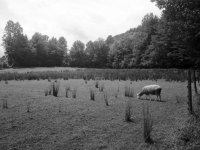Light

I am buliding a solar oven based on this mans plans, where I will bake desert bread in the courtyard here. Solar ovens are a radical, simple technology, reflecting the suns energy, light, and heat in a geometric way to cook food, at temperatures up to 300 degrees farenheit! These ovens are used all over the world, as a primary way of preparing food. The largest solar oven is in India, and produces 38,000 meals a day! A solar oven relies on the cycles of the sun, on sunny days. You don’t need to convert anything into energy, energy is there, all around us, all the time. We are not unlike plants, really, in our use of the directness of the sun. Solar panels too are an amazing photovoltaic phenonmenon—-storing the energy of the sun! No need to destroy something to make something else, nothing is added to the universe, like when coal is burned. The sun renews itself, it is forever, a ball of fire energy in the sky, with a strong gravitational pull. Of course we are drawn to its light, of course it sustains us. We are magnetically connected.
Katie Bachler was our first HDTS Scout, and was in residence from 2012-2013.
The HDTS Scout Residency is dedicated to learning more about the people and places that make up our diverse and ever evolving community.
During Katie’s residency, visitors were invited to drop into the HDTS HQ, the Scout’s home base, to meet Katie, who could be found making maps, hosting conversations, and baking bread – in between her off-site adventures around town and out in the field.
Katie had a lot in store during her time here, including:
- a series of talks featuring local experts
- joining together to create a web of knowledge
- a research library and archive documenting the many spaces, places, plants, and people that make up this special region
- casual conversations with drop in visitors over tea
- site visits and field trips around town
Katie engaged the community by instigating map-making and rag-rug braiding workshops, the Scout’s Book Club, Art in the Environment classes for desert kids, casual conversations, site visits and field trips—all shared in her Scout’s blog, which serves as the foundation for her book.







































